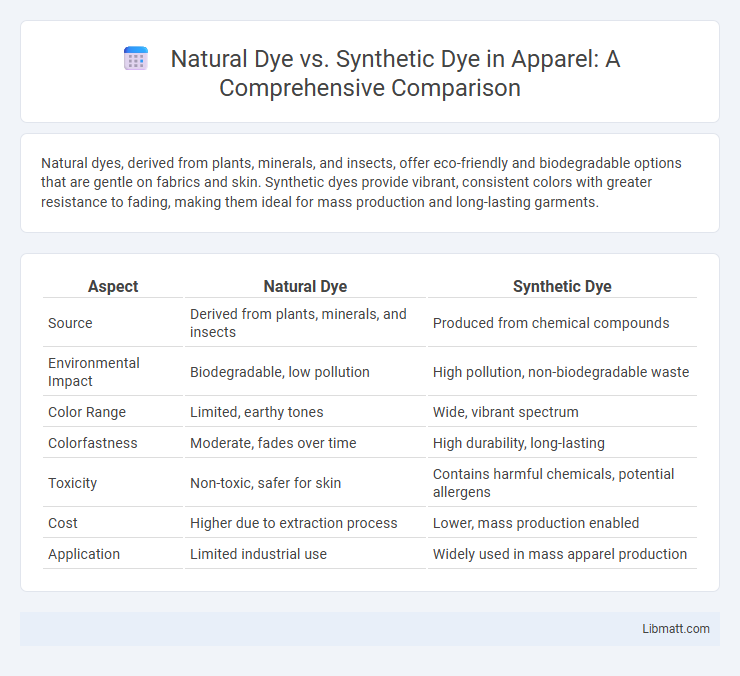Natural dyes, derived from plants, minerals, and insects, offer eco-friendly and biodegradable options that are gentle on fabrics and skin. Synthetic dyes provide vibrant, consistent colors with greater resistance to fading, making them ideal for mass production and long-lasting garments.
Table of Comparison
| Aspect | Natural Dye | Synthetic Dye |
|---|---|---|
| Source | Derived from plants, minerals, and insects | Produced from chemical compounds |
| Environmental Impact | Biodegradable, low pollution | High pollution, non-biodegradable waste |
| Color Range | Limited, earthy tones | Wide, vibrant spectrum |
| Colorfastness | Moderate, fades over time | High durability, long-lasting |
| Toxicity | Non-toxic, safer for skin | Contains harmful chemicals, potential allergens |
| Cost | Higher due to extraction process | Lower, mass production enabled |
| Application | Limited industrial use | Widely used in mass apparel production |
Introduction to Natural and Synthetic Dyes
Natural dyes are derived from plant, animal, or mineral sources, offering eco-friendly and biodegradable options for coloring textiles. Synthetic dyes, produced through chemical processes, provide a broader range of vibrant and consistent colors with enhanced colorfastness. Understanding the differences between these dye types helps you make informed choices based on environmental impact and desired fabric performance.
Historical Background of Dyeing Techniques
Natural dyes have been used for thousands of years, with evidence dating back to ancient civilizations such as the Egyptians, Greeks, and Chinese, who extracted color from plants, insects, and minerals. Synthetic dyes emerged in the mid-19th century following William Henry Perkin's accidental discovery of mauveine in 1856, revolutionizing the textile industry with more vibrant and colorfast options. The shift from natural to synthetic dyes reflects advancements in chemistry and industrialization, transforming global dyeing techniques and production scales.
Composition and Sources of Natural Dyes
Natural dyes derive from organic materials such as plants, minerals, and insects, including indigo from leaves, turmeric from roots, and cochineal from insects. Their composition primarily consists of colorants like flavonoids, carotenoids, and anthraquinones, which bind naturally to fibers without harsh chemicals. Understanding the sources and chemical makeup of natural dyes can enhance your choice for eco-friendly and sustainable textile coloring.
Chemical Structure of Synthetic Dyes
Synthetic dyes possess complex chemical structures often derived from azo, anthraquinone, or phthalocyanine compounds, enabling vibrant and diverse color ranges. Their molecular configuration allows for strong affinity to various fibers, resulting in high colorfastness and durability compared to natural dyes. The presence of specific functional groups in synthetic dyes facilitates targeted bonding mechanisms, enhancing stability against environmental factors like light and washing.
Environmental Impact: Natural vs Synthetic Dyes
Natural dyes generally have a lower environmental impact due to their biodegradability and renewable sources, reducing pollution and chemical waste. Synthetic dyes, made from petrochemicals, often contribute to water contamination and toxic byproducts during manufacturing and disposal. Choosing natural dyes supports eco-friendly practices and minimizes your ecological footprint in textile production.
Colorfastness and Durability Comparison
Natural dyes often exhibit lower colorfastness and durability compared to synthetic dyes, as they tend to fade more quickly under exposure to sunlight and repeated washing. Synthetic dyes provide stronger chemical bonds with fibers, resulting in longer-lasting, vibrant colors that resist fading and wear. Research indicates that while natural dyes are favored for eco-friendliness, synthetic dyes outperform them in maintaining color integrity over time.
Health and Safety Considerations
Natural dyes, derived from plants, minerals, and insects, pose fewer health risks due to their non-toxic and biodegradable properties, making them safer for skin contact and environmentally friendly. Synthetic dyes often contain harmful chemicals such as azo compounds and heavy metals, which can cause allergic reactions, respiratory issues, and environmental pollution during production and disposal. Choosing natural dyes reduces exposure to carcinogenic substances and supports safer manufacturing processes, promoting overall health and safety for both consumers and workers.
Economic Aspects and Market Trends
Natural dyes often incur higher production costs due to labor-intensive extraction processes and limited raw material availability, impacting their market price compared to synthetic dyes derived from petrochemicals. However, growing consumer demand for sustainable and eco-friendly products is driving a shift towards natural dyes, encouraging investment and innovation within this niche market. You can capitalize on this trend by selecting natural dyes to meet environmentally conscious consumer preferences while contributing to a premium product differentiation strategy.
Applications in Textiles and Beyond
Natural dyes extract color from plant, animal, and mineral sources, offering eco-friendly alternatives widely used in artisanal and sustainable textile production, including cotton, silk, and wool. Synthetic dyes, derived from petrochemicals, dominate industrial applications due to their vibrant hues, colorfastness, and cost-effectiveness, extending beyond textiles to plastics, inks, and cosmetics. Both dye types influence environmental impact, with natural dyes favored for biodegradability and synthetic dyes for versatility in large-scale manufacturing processes.
Future Perspectives in Dye Technology
Natural dye technology is gaining renewed interest due to its eco-friendly properties and sustainable sourcing, aligning with global efforts to reduce environmental impact. Innovations in biotechnology and extraction methods are improving the colorfastness and variety of natural dyes, making them more competitive with synthetic alternatives. Your investment in natural dyes supports the future of sustainable fashion and eco-conscious manufacturing practices.
natural dye vs synthetic dye Infographic

 libmatt.com
libmatt.com